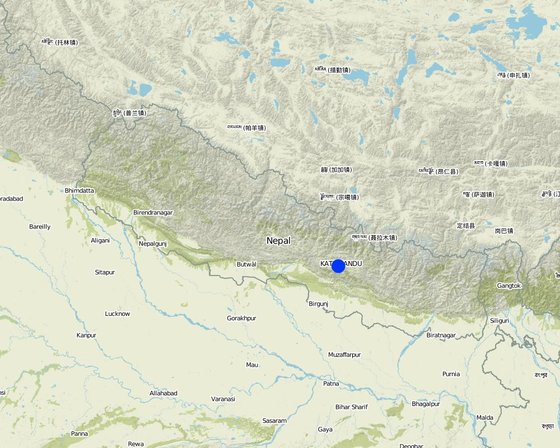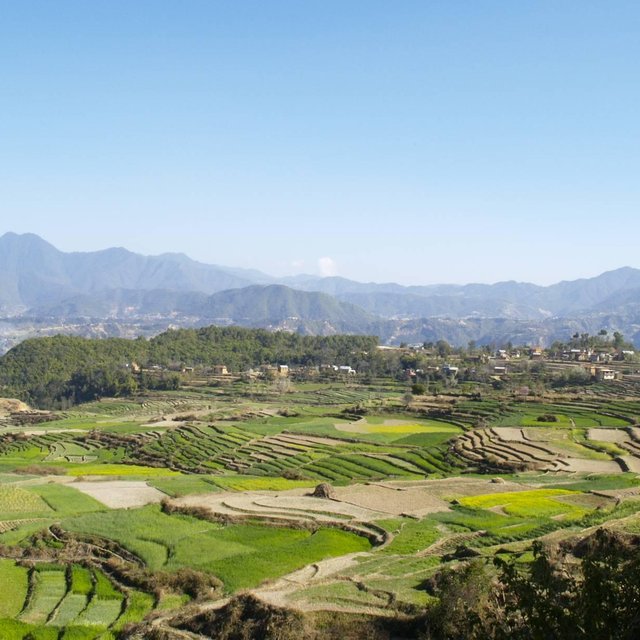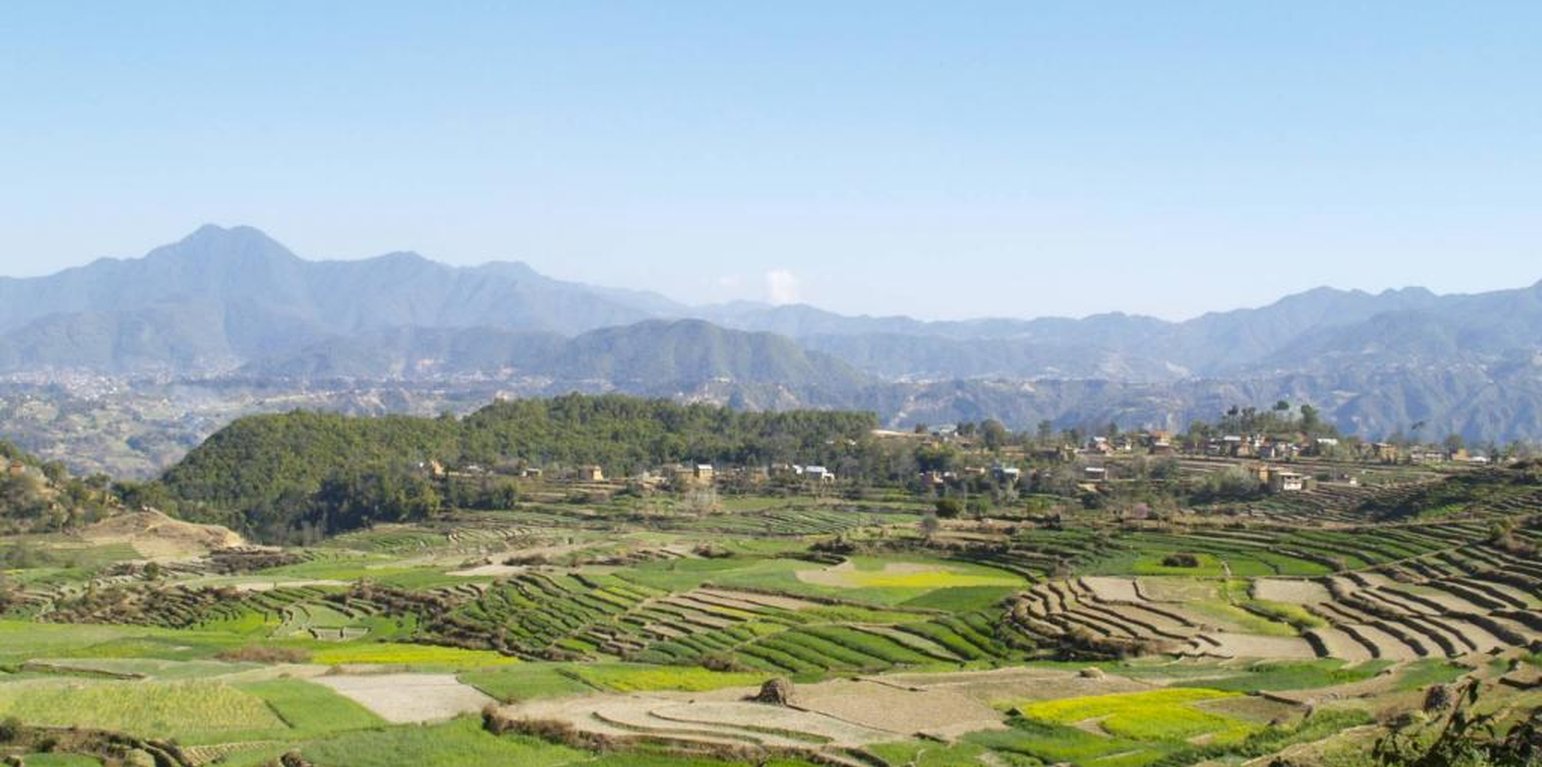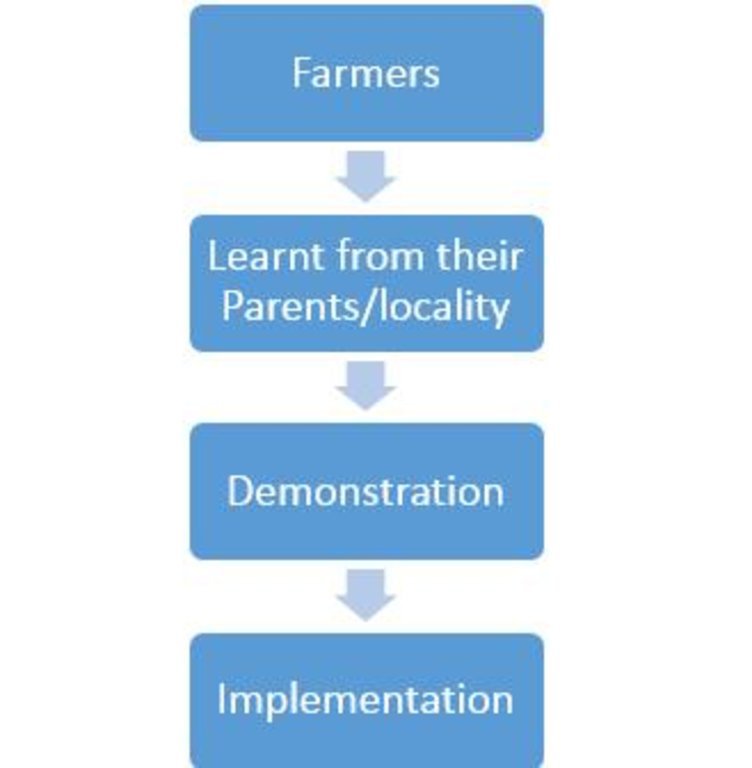Typical newar style rice farming for productivity and soil conservation (by puddling).
(Nepal)
nepali language :- Dhan ropai
Description
Typical Newari style rice farming ages long ,traditional and sustainable way of agriculture that is more focused on increasing rice production and maintaining field's productivity.
Aims / objectives: The main objective of the approach is to study how this indigenous method of rice cultivation is helping to increase rice yield and prevent the land from going barren. It is also centered to know about the involvement of various organizations like local government and INGOs in the process.
Methods: We followed the listed steps.
i)Site Visit
ii)interview with the local farmers
iii)question the labors
iv)literature review through books and intenet
Stages of implementation: i)land preparation
ii)crop preparation
iii)crop transplantation
iv)harvest
Role of stakeholders: Government:-More accessible and affordable and subsidies in budget
More initiative for the farmers in term of knowledge ,training and other technologies
Local administration :-Easy supply of machines,tools chemical fertilizer should be ensured
Other important information: Since it is an indigenous method for rice production,and were in practice for hundred of years, the recent racial mixture and introduction of newer method from terai has resulted into vast change in the methods and methodology of this newari method of typical rice production.
Location

Location: kathmandu, Nepal, Nepal
Geo-reference of selected sites
Initiation date: n.a.
Year of termination: n.a.
Type of Approach
-
traditional/ indigenous
-
recent local initiative/ innovative
-
project/ programme based

Rice farm as seen from near Salyansthan near Kirtipur.
Approach aims and enabling environment
Main aims / objectives of the approach
The Approach focused mainly on other activities than SLM (Productivity of rice crops)
To study the typical approach of rice farming and learn about the problems it is currently suffering.
The SLM Approach addressed the following problems: Low agriculture production due to change in monsoon pattern,decremented soil fertility due to excavation for brick industries and lack of modern techniques and methods to cope the problems.
Conditions enabling the implementation of the Technology/ ies applied under the Approach
Conditions hindering the implementation of the Technology/ ies applied under the Approach
-
Social/ cultural/ religious norms and values: Due to massive introduction of new methods of farming, the typical newari method has been altered. This has resulted into loss of expertise and indigenous knowledge that may cause some serious irreversible loss in Nepalese talenet.
Treatment through the SLM Approach: Government or other institutions should document the newari method of agriculture for future application.
-
Availability/ access to financial resources and services: Farmers have difficulties to arrange fund in off season. Also sometime they need to burrow money at heavy interest.
Treatment through the SLM Approach: Government can provide interest free loan to farmers.
-
Legal framework (land tenure, land and water use rights): Conflicts among locals on resources like water due to extremely limited supply.
Treatment through the SLM Approach: mutual cooperation and advance level of engineering to design water supply for irrigation in the field
The existing land ownership, land use rights / water rights hindered a little the approach implementation Community ownership meant no hindrance for development.
-
Knowledge about SLM, access to technical support: some efficient and new technology (genetically modified crop) and lack of advance equipment for agriculture
Treatment through the SLM Approach: Administration and local authority should address this and inform farmers about the agricultural advancement through Agricultural Ministry.
-
Workload, availability of manpower: Since agriculture is tedious job, farmers are always lacking manpower to help themselves.
Sometimes they are forced to hire expensive workers.
Treatment through the SLM Approach: Government and other institutions should help farmer to get technologies that can help them to decrease their work load.
-
Other: Other constraints may include lack of younger generations interest in farming.
Treatment through the SLM Approach: Better education in schools and establishment of agricultural universities may increase their interest.
Participation and roles of stakeholders involved
Stakeholders involved in the Approach and their roles
| What stakeholders / implementing bodies were involved in the Approach? |
Specify stakeholders |
Describe roles of stakeholders |
| local land users/ local communities |
Land owners in Kirtipur, Kathmandu |
Men are adopting other occupations like moving to middle east or other private job because of better and continuous income and profit. While younger generations are moving abroad for the similar reason. So, the female are mostly limited and focused in the cultivation of the crop. Both male and female is 20s and above 50s who are mostly economically disadvantaged. |
| SLM specialists/ agricultural advisers |
Agrospecialist working on Ministry of Agriculture |
|
| teachers/ school children/ students |
Developing importance of non toixic food production |
|
| NGO |
environmentalist belong to NGOs ,FAO |
|
| local government |
Village Developmental Commitee |
|
| national government (planners, decision-makers) |
Agrospecialist from Ministry of Agriculture and Forest. |
|
| The ancient newari tribe. |
|
|
Involvement of local land users/ local communities in the different phases of the Approach
none
passive
external support
interactive
self-mobilization
initiation/ motivation
Specially promoted by organic business enterprise for exporting them as a better product.
planning
Everything is planned by the local community or the land owner.
implementation
This method is still used by newari community of Nepal.
monitoring/ evaluation
Negative impact from the fertilizer ,the need of organic food production is taking good speed for the better world.for this FAO and other local people are showing their activeness .
Research
For this approach very few research been done and need immediate documentation.
Flow chart
The flowchart shows the hierarchy of this approach. This methodology of rice production was handed over generation over generation. the newer generation learn from the older people from their community.
Decision-making on the selection of SLM Technology
Decisions were taken by
-
land users alone (self-initiative)
-
mainly land users, supported by SLM specialists
-
all relevant actors, as part of a participatory approach
-
mainly SLM specialists, following consultation with land users
-
SLM specialists alone
-
politicians/ leaders
Decisions were made based on
-
evaluation of well-documented SLM knowledge (evidence-based decision-making)
-
research findings
-
personal experience and opinions (undocumented)
Technical support, capacity building, and knowledge management
The following activities or services have been part of the approach
-
Capacity building/ training
-
Advisory service
-
Institution strengthening (organizational development)
-
Monitoring and evaluation
-
Research
Institution strengthening
Institutions have been strengthened / established
-
no
-
yes, a little
-
yes, moderately
-
yes, greatly
Describe institution, roles and responsibilities, members, etc.
Type of support
-
financial
-
capacity building/ training
-
equipment
Further details
Local governing bodies along with some INGOs and NGOs are always ready to help the farmers. Their helps include hybrid seed and occasional seeds.
Monitoring and evaluation
socio-cultural aspects were monitored by land users through observations
economic / production aspects were monitored by land users through observations
Research
Research treated the following topics
-
sociology
-
economics / marketing
-
ecology
-
technology
Small research was done by conducting interview with the land owners and going through literatures of the related topics.
Research was carried out on-farm
Financing and external material support
Annual budget in USD for the SLM component
-
< 2,000
-
2,000-10,000
-
10,000-100,000
-
100,000-1,000,000
-
> 1,000,000
Precise annual budget: n.a.
Approach costs were met by the following donors: local government (district, county, municipality, village etc) (Support from Nepalese government like seeds,fertilizer etc.): 4.0%; local community / land user(s) (Small support from INGOs like FAO,World Bank.): 95.0%; other: 1.0%
The following services or incentives have been provided to land users
-
Financial/ material support provided to land users
-
Subsidies for specific inputs
-
Credit
-
Other incentives or instruments
Financial/ material support provided to land users
partly financed
fully financed
equipment: machinery: tools
Labour by land users was
-
voluntary
-
food-for-work
-
paid in cash
-
rewarded with other material support
Impact analysis and concluding statements
Impacts of the Approach
No
Yes, little
Yes, moderately
Yes, greatly
Did the Approach help land users to implement and maintain SLM Technologies?
This method of rice cultivation is in practice for hundred of years and its success clearly shows that it is effective in soil conservation.
Did the Approach empower socially and economically disadvantaged groups?
There is no much improvement,though they some job opportunity to improve their life style.
Did the Approach improve issues of land tenure/ user rights that hindered implementation of SLM Technologies?
There are no hindrance.
The problem is likely to be overcome in the near future. The approach creates a effective framework that can be used in future.
Did other land users / projects adopt the Approach?
Adopted by some native people of neighboring districts.
Main motivation of land users to implement SLM
-
increased production
-
increased profit(ability), improved cost-benefit-ratio
-
reduced land degradation
-
reduced risk of disasters
-
reduced workload
-
payments/ subsidies
-
rules and regulations (fines)/ enforcement
-
prestige, social pressure/ social cohesion
-
affiliation to movement/ project/ group/ networks
-
environmental consciousness
-
customs and beliefs, morals
-
enhanced SLM knowledge and skills
-
aesthetic improvement
-
conflict mitigation
-
well-being and livelihoods improvement
Sustainability of Approach activities
Can the land users sustain what hat been implemented through the Approach (without external support)?
Yes, we believe that the farmers can keep continuing the approach activities without support as it is very easy and indigenous method for farming.
Conclusions and lessons learnt
Strengths: land user's view
-
1.It is easy method to apply and it increase the soil fertility rate .
2. good quality of rice by the use of puddling process and organic fertilizer. (How to sustain/ enhance this strength: 1. Repair the soil infertility.
)
Strengths: compiler’s or other key resource person’s view
-
1. It is traditional ,unique and indigenous technique.
2.Its been good at yielding more productivity.
3. It is helping soil from getting barren. (How to sustain/ enhance this strength: 1.More facilities,subsidies,loan,etc for farmers.
2.Introduction of innovative and new technologies.
3.Teaching farmers the new and advanced knowledge.)
Weaknesses/ disadvantages/ risks: land user's viewhow to overcome
-
1.Less effective due to lack of equipment and alternative backup plan.
1. More research ,advise center for agriculture development should be provide by by the top level.
Weaknesses/ disadvantages/ risks: compiler’s or other key resource person’s viewhow to overcome
-
1. It cannot be the ultimate way of addressing of per capita income.
2. Many people are showing less interest.
3.It results in relatively less earning and thus very less respected.
1.Change in attitude farming among people.
2.More fund for the research should be allocated.
3. More colleges specialized for agriculture should be established.
References
Date of documentation: Jan. 17, 2014
Last update: Julie 8, 2017
Resource persons
-
Sabita Aryal (sabita@ku.edu.np) - SLM specialist
-
Shyam Sharma - SLM specialist
-
Bibek Shrestha - SLM specialist
-
Shanta Maharjan - SLM specialist
-
Buddhi Maharjan - SLM specialist
Full description in the WOCAT database
Documentation was faciliated by
Institution
- Kathmandu University (KU) - Nepal
Project
Key references
-
wikipedia/internet and article base on organic food(rice farming):






